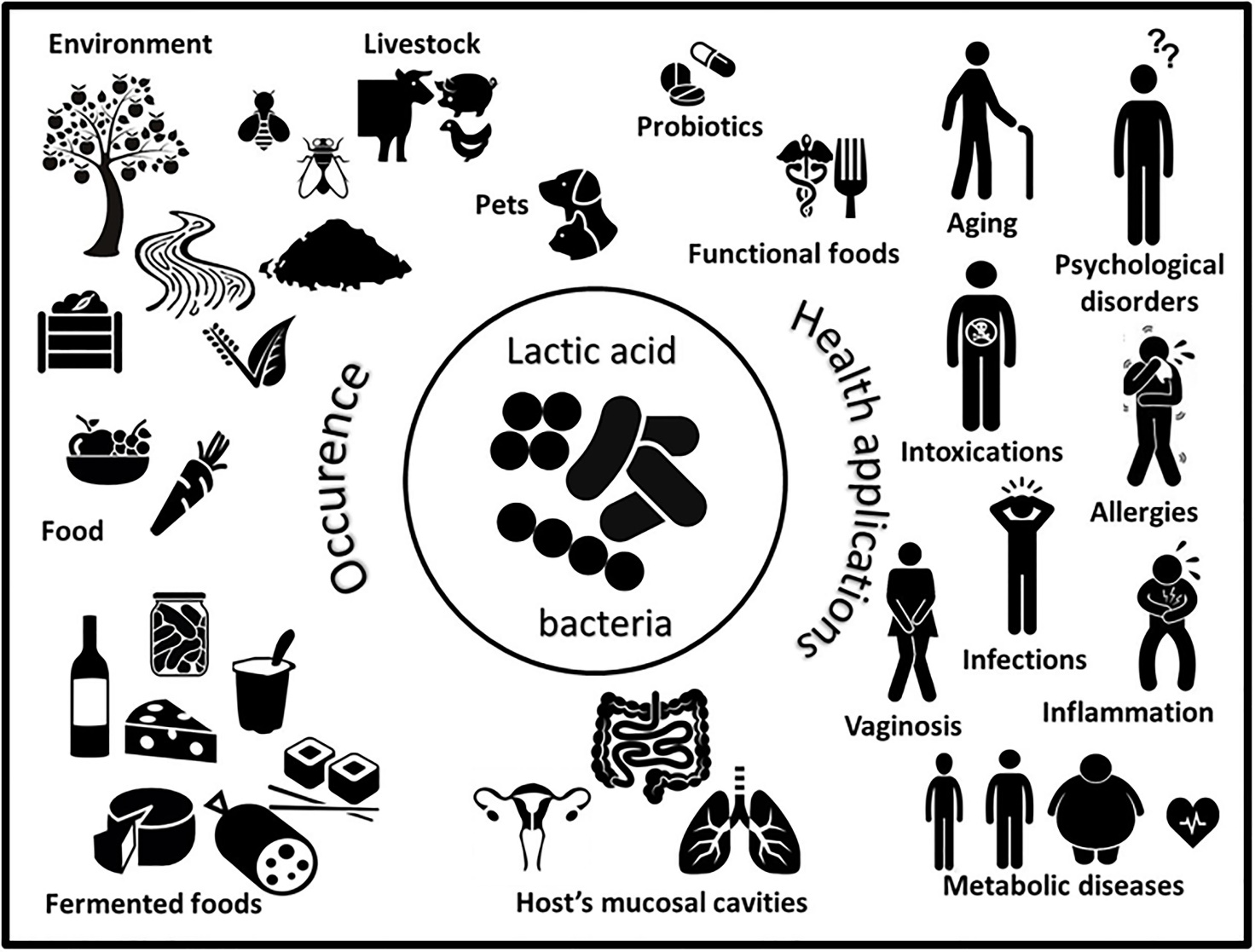Microorganisms in Food & Beverage
What are Microorganisms-
Technically a microorganism or microbe is an organism that is microscopic. Microorganisms can be bacteria, fungi, archaea or protists.
The term microorganisms does not include viruses and prions, which are generally classified as non-living because viruses can replicate themselves only by infecting a host cell. They therefore cannot reproduce on their own. Prions are a recently discovered infectious agent. They are proteins that are folded abnormally
Microorganisms are not similar to each other, they differ not only in size but also in structure, habitat, metabolism and several other characteristics.
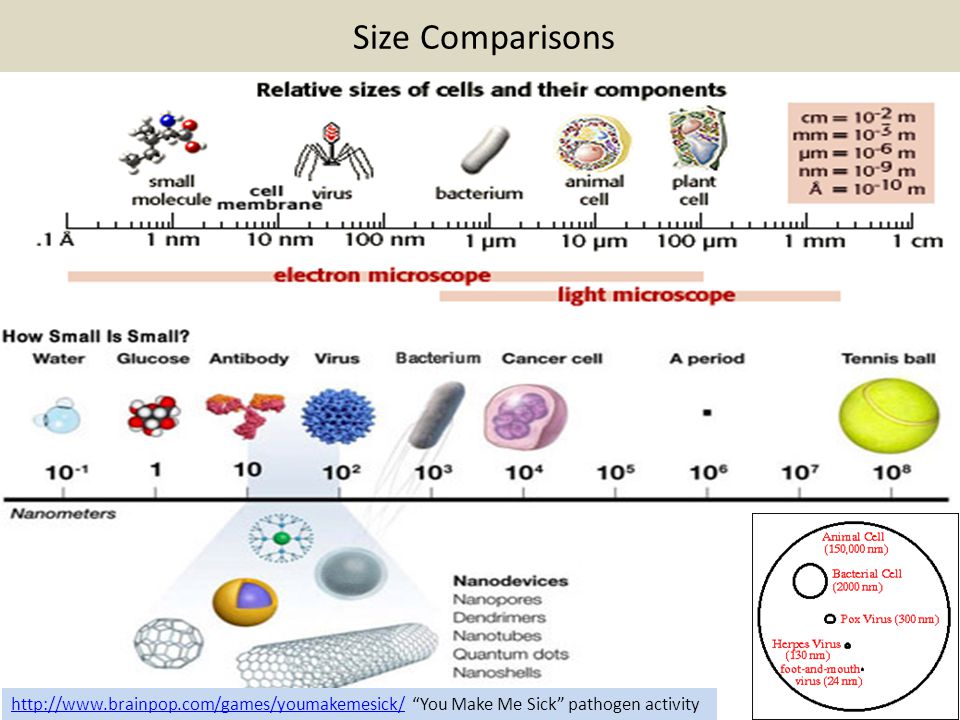
the vast majority of microorganisms do not pose any harm or threat to humans, plants or animals. In fact, they work alongside humans to make the world go round like they help in decomposition, decay and also help us to digest food in our body.
there are some microorganisms which pose a negative impact or harm us like they cause illness, bad odours, can even damage certain products, surfaces, etc. Some common names of microorganisms that we mostly hear are Salmonella, E.Colli, MRSA, Malaria, Bird flu.
Currently, more than 3500 traditionally fermented foods exist in the world. They are of animal or vegetable origin and are part of our daily life. Alcoholic drinks are not the only fermented drinks; cocoa beans, coffee grains and tea leaves are fermented after harvest in order to develop their typical flavour profiles.
A bit of history
The first realisation that microorganisms were involved in food production processes was in 1837, when scientists discovered the role of yeast in an alcoholic fermentation.
Later, when the world renowned French chemist and biologist Louis Pasteur was trying to explain what happened during the production of beer and vinegar in the 1860es, he found that microorganisms were responsible.

French chemist and biologist Louis Pasteur
Classification of Microorganisms
Microorganisms in food production
Nature uses microorganisms to carry out fermentation processes, and for thousands of years mankind has used yeasts, moulds and bacteria to make food products such as bread, beer, wine, vinegar, yoghurt and cheese, as well as fermented fish, meat and vegetables.
What Is Fermentation?
Fermentation is any metabolic process in which microorganisms’ activity creates a desirable change in food and beverages, whether it’s increasing flavor, preserving foodstuffs, providing health benefits, or more. The word “ferment” comes from the Latin verb “fervere,” which means “to boil.” Ironically, fermentation is possible without heat.
How Does Fermentation Work?
Microorganisms survive using carbohydrates (sugars, such as glucose) for energy and fuel. Organic chemicals like adenosine triphosphate (ATP) deliver that energy to every part of a cell when needed. Microbes generate ATP using respiration.
Fermentation occurs in the absence of oxygen (anaerobic conditions), and in the presence of beneficial microorganisms (yeasts, molds, and bacteria) that obtain their energy through fermentation. If enough sugar is available, some yeast cells, such as Saccharomyces cerevisiae, prefer fermentation to aerobic respiration even when oxygen is abundant.

Different Types of Fermentation?
There are basically 03 types of fermentation process:-
- Lactic acid fermentation
- Acetic acid fermentation
- Ethanol fermentation or alcohol fermentation.
Lactic acid Fermentation: – Yeast strains and bacteria convert starches or sugars into lactic acid, requiring no heat in preparation. These anaerobic chemical reactions, pyruvic acid uses nicotinamide adenine dinucleotide + hydrogen (NADH) to form lactic acid. Lactic acid bacteria are vital to producing and preserving inexpensive, wholesome foods, which is especially important in feeding impoverished populations.
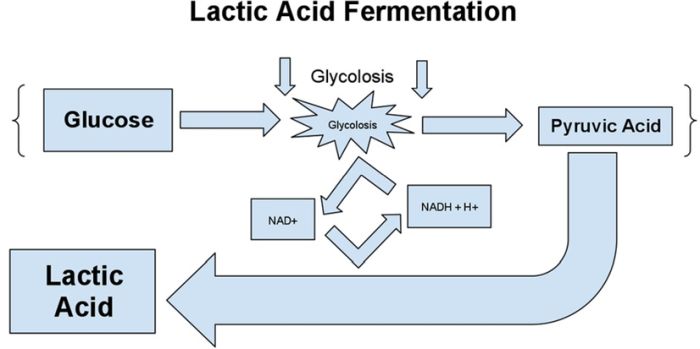
This method makes sauerkraut, pickles, kimchi, yogurt, and sourdough bread.
Acetic acid fermentation:- A process of oxidation in which alcohol is converted into acetic acid by the agency of bacteria of the genus Acetobacter, especially A. aceti (as in the production of vinegar from cider or wine) Starches and sugars from grains and fruit ferment into sour tasting vinegar and condiments. Examples include apple cider vinegar, wine vinegar, and kombucha.

Ethanol fermentation or alcohol fermentation:- Alcohol fermentation, also known as ethanol fermentation, is a biological process which converts sugars such as glucose, fructose, and sucrose into cellular energy, producing ethanol and carbon dioxide Yeasts typically function under aerobic conditions, or in the presence of oxygen, but are also capable of functioning under anaerobic conditions, or in the absence of oxygen.
The process of alcohol fermentation can be divided into two parts. In the first part, the yeast breaks down glucose to form 2 pyruvate molecules. This part is known as glycolysis. In the second part, the 2 pyruvate molecules are converted into 2 carbon dioxide molecules and 2 molecules of ethanol, otherwise known as alcohol. This second part is called fermentation.
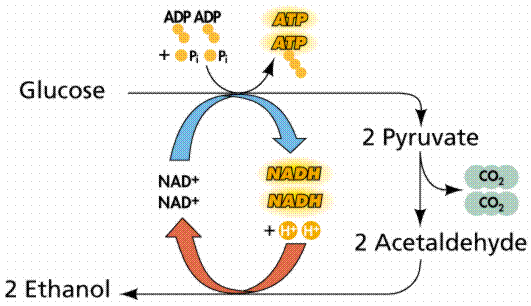
Ethanol fermentation has many uses, including the production of alcoholic beverages, the production of ethanol fuel, and bread cooking.
What Happens During the Fermentation Process?
During the fermentation process, these beneficial microbes break down sugars and starches into alcohols and acids, making food more nutritious and preserving it so people can store it for longer periods of time without it spoiling. Fermentation products provide enzymes necessary for digestion. This is important because humans are born with a finite number of enzymes, and they decrease with age. Fermented foods contain the enzymes required to break them down.
What Are the Advantages of Fermentation?
Fermented foods are rich in probiotics, beneficial microorganisms that help maintain a healthy gut so it can extract nutrients from food.
- Probiotics aid the immune system because the gut produces antibiotic, anti-tumor, anti-viral, and antifungal substances, and pathogens don’t do well in the acidic environment fermented foods create.
- Fermentation also helps neutralize anti-nutrients like phytic acid, which occurs in grains, nuts, seeds, and legumes and can cause mineral deficiencies. Phytates also make starches, proteins, and fats less digestible, so neutralizing them is extremely beneficial.
- Fermentation can increase the vitamins and minerals in food and make them more available for absorption. Fermentation increases B and C vitamins and enhances folic acid, riboflavin, niacin, thiamin, and biotin. The probiotics, enzymes, and lactic acid in fermented foods facilitate the absorption of these vitamins and minerals into the body.
Most bacteria are single-celled organisms which reproduce by simple division. There are three main forms:
Cocci Bacteria are spherical,
Bacilli Bacteria are rod-shaped, and
Spirilla Bacteria are spirals.
They live everywhere, from soil to water to within animals and plants, and are highly adapted to their environment – they are even found in volcanoes and radioactive waste.
Bacteria play an essential role in recycling nutrients, for example fixing nitrogen from the atmosphere into the soil. The human body contains vast numbers of bacteria, most of which are harmless or rendered so by the immune system, and some are vital in processes such as digestion. Bacteria are commonly used in the production of variety of dairy products. Bacteria are used to make a wide range of food products. The most important bacteria in food manufacturing are Lactobacillus species, also referred to as lactic bacteria.
lactic bacteria also play an important role as they form the ‘sour dough’ fermentation. This offers a number of benefits to bakers, such as a dough that is easy to handle and uniform, with a shorter resting time, a good aroma and a product that stays fresher for longer. Lactic bacteria are also playing an important role in the preparation of sauerkraut.
The basic distinction divides living organisms into two groups: prokaryotes (cells without internal membrane bound organelles – the monera, including most microorganisms) and eukaryotes (cells containing membrane bound organelles – protists, fungi, plants and animals).
Bacteria are found all around us. Most bacteria are harmless, some are helpful, and some can make you sick. Bacteria play a role in a variety of products, from cultured dairy to soy sauce. When temperature and moisture conditions are favorable, bacterial pathogens also grow on foods. Bacteria will grow in warm, moist environments, but will be slowed by high heat or cold temperatures.
A fungus is a living organism that includes yeast and molds. Some are beneficial in culinary applications, while others are undesirable. Mushrooms and truffles are popular fungi in culinary preparations. Yeast is necessary in the bread, wine, and beer making processes.
Bacteria in food production
Bacterial food cultures can be divided into starter cultures and probiotics.
Starter cultures have mainly a technological function in the food manufacturing. Probiotics have a functional role, which refers to the ability of certain microbes to confer health benefits to the consumer. Generally, the bacteria used as starter culture are not the same used as probiotics. The most important bacteria in food manufacturing are Lactobacillus species, belonging to the group of lactic acid bacteria
Bacterial food cultures are responsible for the aroma, taste and texture of cheeses and fermented milk products such as yogurts, ayran, doogh, skyr or ymer. They contribute to developing the flavour and colour of such fermented products as salami, pepperoni and dried ham.
Most bacteria are single-celled organisms which reproduce by simple division. There are three main forms: cocci are spherical, bacilli are rod-shaped, and spirilla are spirals. They live everywhere, from soil to water to within animals and plants, and are highly adapted to their environment – they are even found in volcanoes and radioactive waste.
Bacteria play an essential role in recycling nutrients, for example fixing nitrogen from the atmosphere into the soil. The human body contains vast numbers of bacteria, most of which are harmless or rendered so by the immune system, and some are vital in processes such as digestion.
A starter culture is a microbial culture which actually performs fermentation. Starter preparations assist the beginning of the fermentation process in preparation of various foods and fermented drinks. A number of bacterial and other microbial strains have been used either in single or in combination for producing the desired effect in the finished product. The bacteria used in the manufacture of fermented dairy products are generally lactic acid bacteria (LAB).
There are currently sixteen common type of Lactic acid bacteria like Enterococcus, Lactobacillus, Lactococcus, Leuconostoc, Oenococcus, Pediococcus, Streptococcus and Tetragenococcus etc are mostly used in food fermentations
Production of microbial cultures in the dairy industry
Bacteria are commonly used in the production of variety of dairy products. Bacteria are used to make a wide range of food products. The most important bacteria in food manufacturing are Lactobacillus species, also referred to as lactic bacteria.
It would be impossible to make cheese without a starter culture. As the culture grows in the milk, it converts the sugar lactose into lactic acid, which ensures the correct level of acidity and gives the cheese its moisture. As the cheese ripens, the culture gives it a balanced aroma, taste, texture. It is also responsible for the ‘holes’ in cheeses such as Emmenthal. Choosing the right mixture of culture is essential for a high-quality cheese.
Example of common cheese culture-
- Fresh Cheese Culture is an aromatic mesophilic culture used in producing soft cheeses such as Cottage Cheese, Neufchatel, Chevre.
- Mesophilic Direct-Set Cheese Culture (MA11) is a versatile cheese culture that can be used to make flavorful semi-soft and fresh cheeses at home, from Cheddar, Colby, and Monterey Jack to Feta, Chèvre, and more.
Mesophilic Aromatic Type B is another versatile cheese culture with a buttery flavor. It is used for making sour cream and cultured butter, soft cheeses such as Goat Cheese, Cream Cheese and Cottage Cheese, and other specialty cheeses such as Havarti and Camembert- MM Series Starter Culture is used to make Brie, Camembert, Havarti, Gouda, Edam, Feta, Blue Cheese, Chevre, and other buttery, open-textured cheeses.
- Thermophilic Direct-Set Starter Culture (TA 61) is used for making hard cheeses such as Parmesan, Romano, Provolone, Mozzarella, Emmental/Swiss.
 | 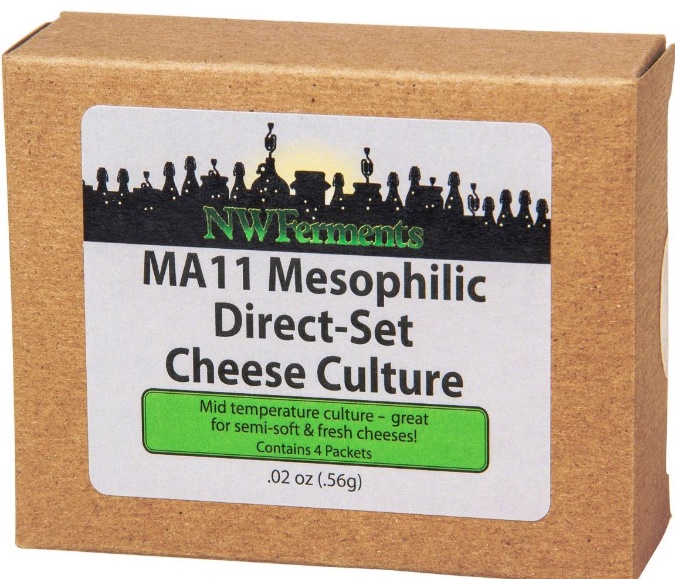 |
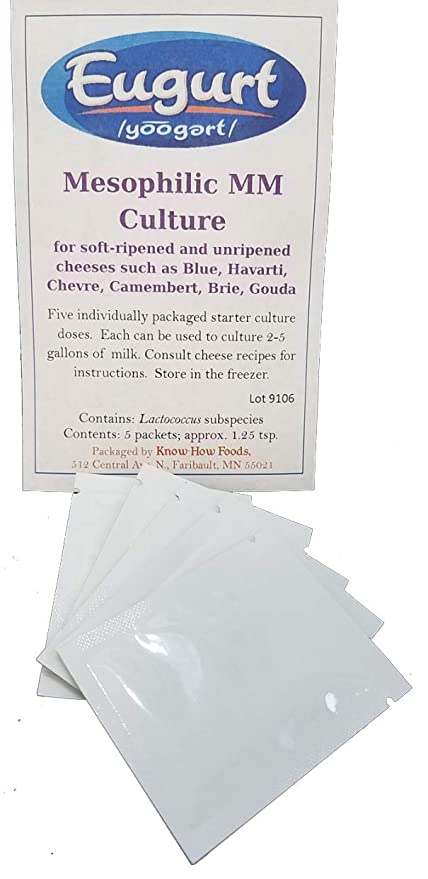 | 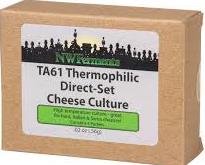 |
MOLDS USED IN CHEESEMAKING
Molds are responsible for giving some cheeses their specific flavor and texture. They are usually applied to the outside of the cheese where they form a crust.
- Penicillium Camemberti white mold spores are used for making Camembert and Brie cheeses and are essential in the ripening process of cheeses with white surface mold.
- Penicillium Roqueforti mold spores are used for making Blue Cheese and are essential in the ripening process.
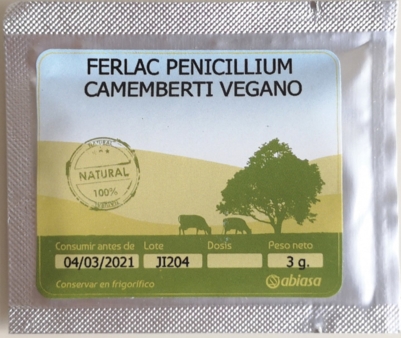 | 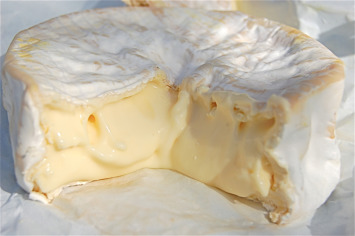 |
 | 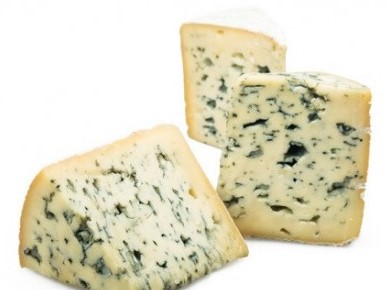 |
In yoghurt and other fermented milk products, the culture is responsible for the taste and texture of the final product. Depending on the acidity, the product will have either a mild or strong taste, and the viscosity depends on the quantity of polysaccharides – chains of sugar molecules – that are produced.
Yogurt is a fermented milk product that contains the characteristic bacterial cultures Lactobacillus bulgaricus and Streptococcus thermophilus. The function of the starter cultures is to ferment lactose (milk sugar) to produce lactic acid. The increase in lactic acid decreases pH and causes the milk to clot, or form the soft gel that is characteristic of yogurt. All yogurt must contain at least 8.25% solids not fat. Full fat yogurt must contain not less than 3.25% milk fat, lowfat yogurt not more than 2% milk fat, and nonfat yogurt less than 0.5% milk
 | 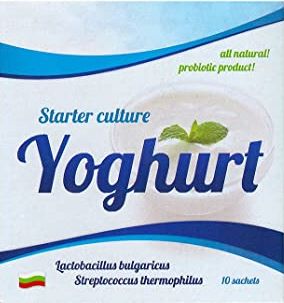 |
Production of microbial cultures in meat industry
Meat starter cultures are used to make dried, fermented products such as salami, pepperoni, chorizo and dried ham. Lactic bacteria develop the flavour and colour of the products. In addition, a wide variety of moulds are use to ripen the surface of sausages, preserving the natural quality of the product and controlling the development of flavour.
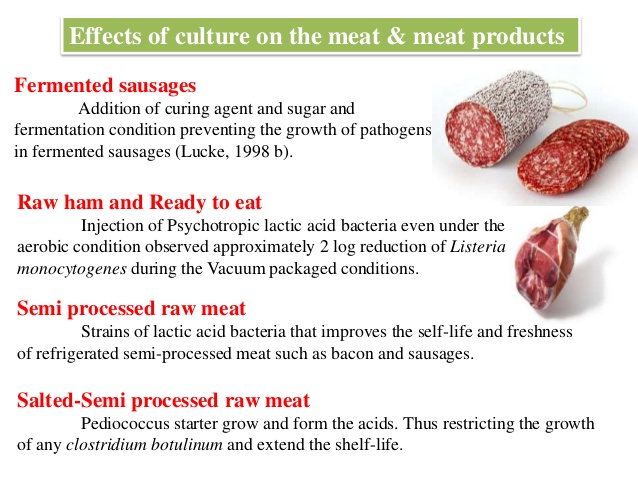
Production of microbial cultures in wine industry
Yeasts are responsible for the fermentation process which produces alcohol in wine. The transformation of grape must in wine is a complex microbiological process, which includes two main fermentation processes: alcoholic, operated by yeasts, and malolactic, performed by lactic acid bacteria. Alcoholic fermentation in wine making process , mainly achieved by Saccharomyces cerevisiae, leads to formation of many alcohols and esters
Lactic acid bacteria (LAB) are one of the most relevant groups of microorganisms in winemaking. They are responsible for the decarboxylation of malic acid to lactic acid in a process known as malolactic fermentation that usually takes place after the alcoholic fermentation. Malolactic fermentation is a process required for most red wines and some white wines; it makes wines more palatable by reducing the tart taste associated to malic acid, and provides additional advantages, like microbial stability and improved aroma complexity. Oenococcus oeni is a typical bacterial species isolated from spontaneous malolactic fermentation processes
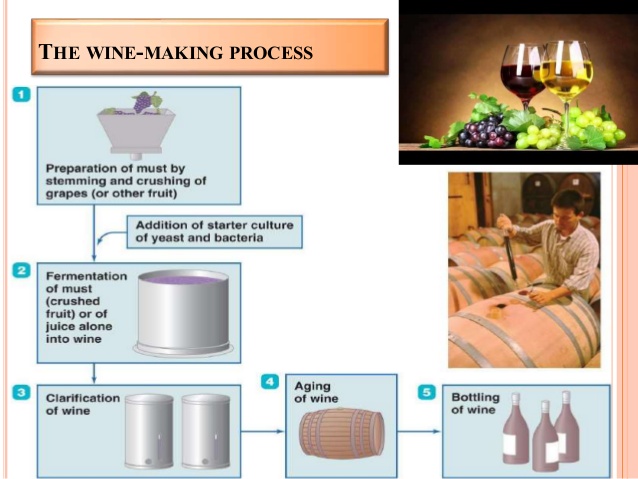
Pic source-slideshare.net
Production of microbial cultures in health food industry
Lactic bacteria are used in many different tablets and capsules sold as supplements in the healthfood industry. Our hectic modern lifestyles often lead to an imbalance in the intestinal flora; travel and medical treatment are two of the major culprits. By taking supplements containing lactic bacteria, this balance can be restored, improving the quality of life. Probiotics are considered generally safe to consume, but may cause bacteria-host interactions and unwanted side effects in rare cases
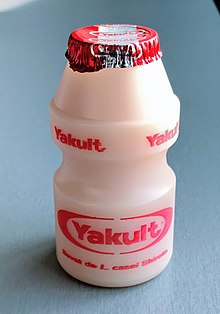 |  |

What is Yeast & its use in Food Industry
Yeast is an egg-shaped single-cell fungus that is only visible with a microscope and are found worldwide in soils and on plant surfaces and are especially abundant in sugary mediums such as flower nectar and fruits, which needs food, warmth, and moisture to thrive. To grow, yeast cells digest food and this allows them to obtain energy.
It converts its food—sugar and starch—through fermentation, into carbon dioxide and alcohol. It’s the carbon dioxide that makes baked goods rise and used in the production of bread, beer, and wine etc.
Basic Role of yeast in Fermentation: –
the yeast ferments the sugars in the flour and releases carbon dioxide. Because the dough is elastic and stretchable, the carbon dioxide cannot escape. The expanding gas causes the dough to inflate or rise. Yeast is also an essential ingredient in brewing beer. The yeast eats the sugar in beer and produces carbon dioxide and alcohol.

Types of Yeast: –
There are two types of yeast available:
- Brewer’s yeast, a wet yeast used primarily in beer making
- Baker’s yeast, which is used as a leavening agent
Brewer’s Yeast:-Brewer’s yeast is an ingredient used in the production of beer and bread. It is made from Saccharomyces cerevisiae, a one-celled fungus. Brewer’s yeast has a bitter taste.
Baker’s Yeast: – Baker’s yeast, which is used as a leavening agent. There are then two types of baker’s yeast—
Fresh yeast and Dry yeast.
Fresh yeast- also called wet, cake, and compressed yeast comes in small square cakes that are made of fresh yeast cells. These blocks of fresh yeast, often used by professional bakers, are comprised of 70 percent moisture, and therefore are quite perishable.
 |  |
Dry yeast- There are two types of dry yeast: Active dry yeast and instant yeast. The only difference between the two is the size of the granules; active yeast has larger granules while instant has been ground into a finer texture. Instant is named as such because it can be added directly to other ingredients; it does not need to be dissolved in water before using as active dry yeast does. Active dry yeast is dormant until proofed, which occurs when it is dissolved in a small amount of lukewarm water (about 110 degrees Fahrenheit).
Instant yeast is also available as rapid or quick rising. This type of yeast includes enzymes and additives to help the dough rise faster. When using rapid-rise yeast, it will take half of the time to make bread rise, or if the recipe calls for two sets of rising times, you can skip one of them and proceed to kneading and shaping the loaves.
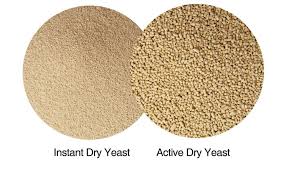 | 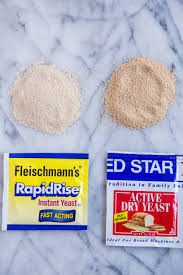 |
Yeasts use in food production
Yeasts have two main uses in food production: baking and making alcoholic beverages. They have been used in this way since ancient times – there is evidence that ancient Egyptians used yeast in breadmaking, and we have been making fermented drinks like beer and wine for millennia.
Baking
Baked goods like bread rise because of the presence of yeast as a raising, or leavening, agent. The most common yeast used in breadmaking is Saccharomyces cerevisiae. It feeds on the sugars present in the bread dough, producing the gas carbon dioxide. This forms bubbles within the dough, causing it to expand. Other ingredients in the mixture have an effect on the speed of the fermentation – sugar and eggs speed it up; fats and salt slow it down.
Brewing
Several different yeasts are used in brewing beer, where they ferment the sugars present in malted barley to produce alcohol. One of the most common is Saccharomyces cerevisiae, the same strain used in breadmaking; this is used to make ale-type beers and is known as a top-fermenting yeast as it forms a foam on the top of the brew. Bottom-fermenting yeasts, such as Saccharomyces pastorianus, are more commonly used to make lagers. They ferment more of the sugars in the mixture than top-fermenting yeasts, giving a cleaner taste.
Winemaking
The alcohol in wine is formed by the fermentation of the sugars in grape juice, with carbon dioxide as a byproduct. Yeast is naturally present on grapeskins, and this alone can be sufficient for the fermentation of sugars to alcohol to occur. A pure yeast culture, most often Saccharomyces cerevisiae, is usually added to ensure the fermentation is reliable. Sparkling wine is made by adding further yeast to the wine when it is bottled. The carbon dioxide formed in this second fermentation is trapped as bubbles.
Point to remember while using Yeast: –
- Yeast needs warm temperatures to activate, so when placing the dough to rise, make sure it is sitting in a place that is 70 to 80 degrees Fahrenheit. And if your recipe includes a lot of eggs, butter, sugar, and milk, you may need a little more patience; these ingredients slow down the leavening process. If not used right away, fresh yeast can be stored in the refrigerator for up to only three days, so it should be bought in amounts that will be used quickly.
- The fresh yeast cake has a stronger smell than dry yeast. It is light beige in color and soft and crumbly in texture. Since it is highly perishable, fresh yeast cakes are stored in the dairy case near the butter.
- Once exposed to the air, the yeast should be stored in the refrigerator. You can store yeast in the freezer, which will pause its activity and prolong its shelf life. Just be sure to place it in a well-sealed container before freezing.
What is Molds?
Mold is a living organism that belongs to the kingdom Fungi. Fungi are unique in that although some appear plant-like, they are neither plant nor animal. Mold is heterotrophic, meaning it cannot make its own food like plants do. Mold must gain nutrients from other organic substances. Unlike animals, however, mold does not really ‘eat’ its food. It must absorb nutrition from other organisms. To do this, mold secretes enzymes that break down the food substance into smaller organic molecules that can then be absorbed. If you’ve ever grabbed a piece of moldy fruit, you may have felt the soft and mushy area that has essentially been digested. Mold is a common type of fungus that thrives in moist, warm conditions. It is an important part of our ecosystem
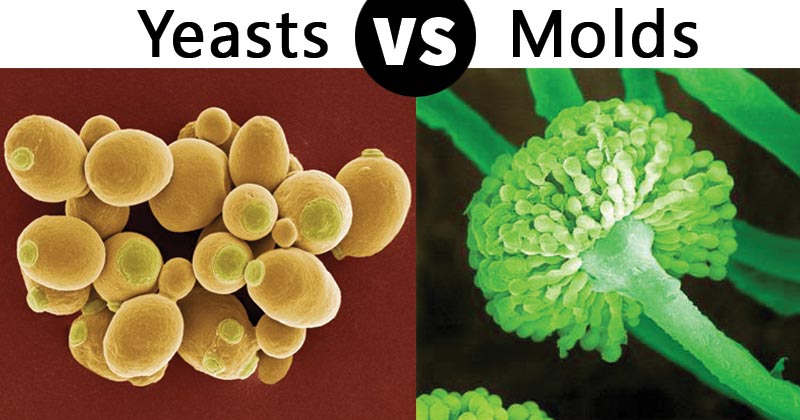
Pic source-onlinemicrobiology
| Molds in bread | Molds in orange |
 | 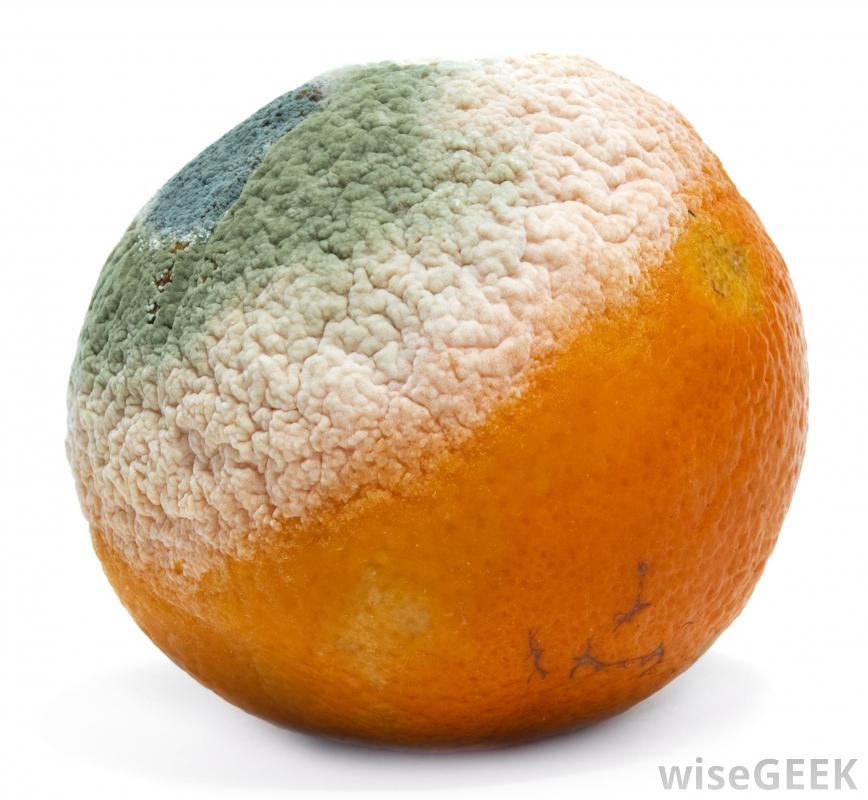 |
Mold is composed of thread-like filaments called hyphae. The hyphae then form a conglomerate, which is called a mycelium.
Some beneficial use of Molds in Food industry as well as in Medical industry
Molds in Food:
Cheese – White molds on the rinds of Brie and Camembert cheese contribute to their smooth creamy texture and unique aroma. Blue molds create striking veins in blue cheeses like Stilton and contribute a peppery taste and distinct aroma.
Soy Foods – Fermented soy sauce, miso and tempeh owe much of their desirable taste and texture to mold fermentation.
Molds in Medicine:
Antibiotics and other drugs – Penicillin and other essential antibiotics were developed from molds, as were some other medications.
Molds in Manufacturing:
Enzymes – Molds are used industrially to produce enzymes that are used in the production of other products. For example, mold can be used to make the enzyme rennet that curds milk for cheese production.
Molds in the Environment:
Decay – Molds play a key role in the break down of organic materials and recycle nutrients back through our ecosystem.
How to prevent Molds growth in food items:-
Other molds are clearly harmful, causing mold-induced allergies and respiratory problems. Mold-based toxins can also make people sick. Mold growth is encouraged by warm and humid settings.
- covering food to prevent mold spores in the air from taking hold
- keeping perishable foods in the refrigerator – don’t leave any perishables out of the fridge longer than 2 hours
- using clean storage containers when putting away leftovers and store in the fridge as soon as possible
- using leftovers within 3 to 4 days
- cleaning the inside of the fridge every few months to limit the risk of mold growth and cross-contamination with food
- using a new dishcloth daily or regularly clean dishcloths or sponges—if they smell musty, mold is growing on them.
- washing the dish cloth out after each use, using hot water and detergent and leave to air dry before reusing;
- carefully handling moldy foods to prevent spreading mold spores around – check other surrounding foods to make sure the mold did not spread
what is Virus?
Viruses are the smallest of all the microbes. They are said to be so small that 500 million rhinoviruses (which cause the common cold) could fit on to the head of a pin. They are unique because they are only alive and able to multiply inside the cells of other living things. The cell they multiply in is called the host cell.
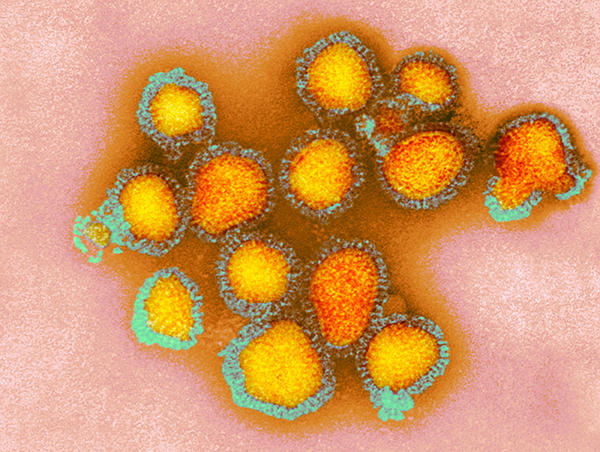
Pic source-© CDC / Science Photo Library
A Virus is a small parasite that cannot reproduce by itself. however, a virus can direct the cell machinery to produce more viruses. Most viruses have either RNA OR DNA as their genetic material. The Nucleic acid may be single- or double-stranded. The entire infectious virus particle, called a virion, consists of the nucleic acid and an outer shell of protein. The simplest viruses contain only enough RNA or DNA to encode four proteins. The most complex can encode 100 – 200 proteins. A virus is made up of a core of genetic material, either DNA or RNA, surrounded by a protective coat called a capsid which is made up of protein.
How big are viruses?

Pic source-viralzone
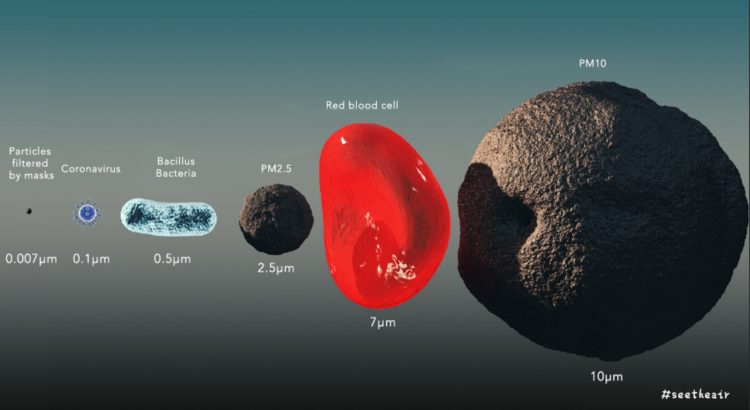
Pic source-smartairfilter.com
The micrometre (symbol:- μm) are also commonly known micron, is an SI Derived Unit of Length equalling 1×10−6 metre that is, one millionth of a metre (or one thousandth of a millimetre, 0.001 mm, or about 0.000039 inch.
The next smallest common SI unit is the nanometer, equivalent to one one-thousandth of a micrometer, or one billionth of a metre (0.000000001 m).

Food borne virus
Food borne virus infections are predominantly transmitted via the fecal-oral route through ingestion of contaminated food and/or water, or through a secondary route of infection and/or by person-to-person contact.
Virus contamination of food products can occur either at pre-harvest or post-harvest. Foods at risk of contamination at the pre-harvest stage, essentially resulting from environmental pollution, include bivalve mollusks particularly oysters, clams and mussels, salad crops, such as lettuce, green onions and other leafy greens, and soft fruits, such as raspberries and strawberries. Improper food-handling through poor hygienic practices is responsible for the majority of post-harvest contamination, mostly involving ready to eat food like sandwiches, cold cuts and pastries. Many outbreaks have been caused by infected workers harvesting the crop, or by food handlers in restaurant and home settings and been linked to salad crops and soft fruits.


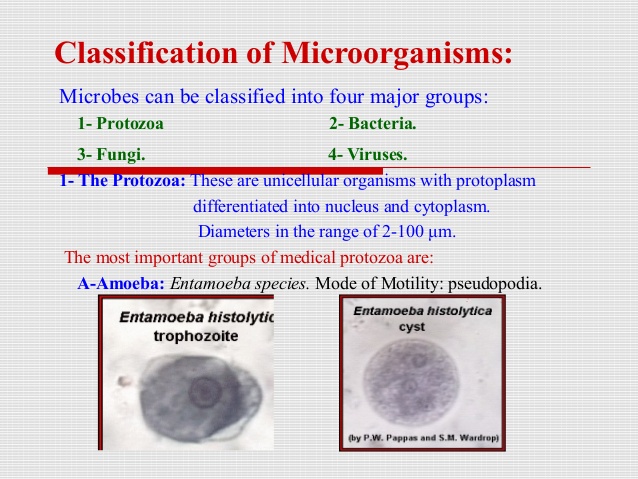
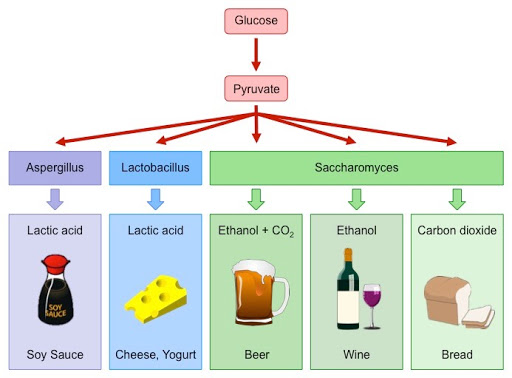
![PDF] Lactic Acid Bacteria as Source of Functional Ingredients ...](https://storage.googleapis.com/media.ookul.co/chefs.ookul.co/2024/09/f72d42f3-pdf-lactic-acid-bacteria-as-source-of-functional.png)
